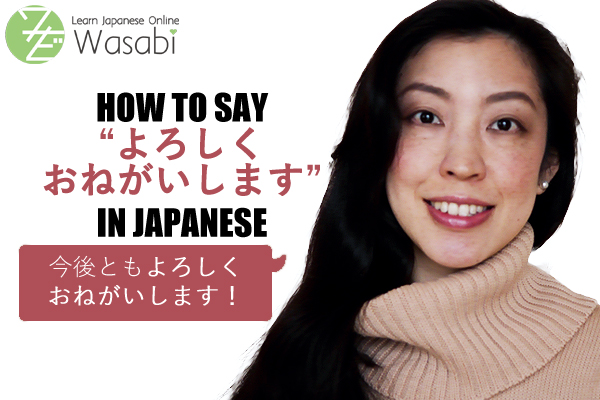How to use “Yoroshiku Onegaishimasu” in Japanese
Welcome back to another “Video & Article” series, this time for our first live-stream with tutor Wakako. In this article and video, Wakako introduces the very common sentence “Yoroshiku Onegaishimasu”. You will learn the meaning, origin, and most importantly how to use this phrase naturally in all kinds of situations.
[Introduction]
Today we will introduce a very common Japanese expression, namey “よろしくお願いします”. This expression, similar to expressions like “いってらっしゃい” or “いってきます”, is very commonly used in Japanese but cannot be directly translated into English.
[Various translationf of “よろしくお願いします”]
Some English translations for “よろしくお願いいたします” include:
- Thank you for your continued help
- Thank you very much in advance
- I look forward to working with you
- I look forward to seeing you
Which one is most accurate depends on the situation you use “よろしくお願いします” in.
[Situations to use “よろしくお願いします” in]
Japanese people love this phrase and use it almost every day both in business and private situations.
One of the most common situations you use this phrase in is when you introduce yourself.
はじめまして、和佳子といいます。よろしくお願いします。
Nice to meet you. I’m Wakako. I look forward to knowing each other.
Another situation you often use it is when you ask somebody to do something, or when you ask someone a favour.
この資料を明日までに作っておいてくれますか?よろしくお願いします。
Could you make this document by tomorrow? Thank you very much in advance.
[adsense]
[When to just use “よろしく”]
If you are the boss of the person you are asking something of, or if you are in a higher position than them, you can shorten the phrase to just “よろしく”.
“よろしく” sounds more casual so you can use it with friends in casual situations as well.
A: タツヤくん、明日このノート貸してくれる?
A: Hey Tatsuya, can I borrow your notebook tomorrow?
B: うん、いいよ
B: Sure, no problem.
A: よろしく
A: Thanks in advance.
[The Timing of “よろしくお願いします”]
Now we’ll get to an important point regarding this phrase.
“よろしくお願いします” or “よろしく” are used when referring to an action to take place in the future. That’s why you can use it to mean “Thank you in advance”. However, if you – using the example from above – borrow his notebook right now, you can’t say “よろしく” to mean “Thank you” because the action you are thanking the other person for is happening in the present. In that case, you can simply say “ありがとう” instead of “よろしく”.
[Using “よろしくお願いします” in strict business situations]
“よろしくお願いします” itself is a polite phrase, but if you want to make it extremely polite, you can say “よろしくお願い致します”.
If you talk with a customer or client in a business scene, you should use very polite words, so “よろしくお願い致します” or “どうぞよろしくお願い致します” are suitable.
どうぞ よろしく お願い致します。
“どうぞ” is a word used to show your politeness when you ask or wish something, so it means “please”.
“よろしく” is used to show your friendliness or goodwill when you ask something.
“いたします” is a humble form of “する” and is used in the “masu”-form here.
These phrases are not only used in speaking Japanese but also used in written Japanese. When you write emails to customers, clients, or even your colleagues, you can use this phrase at the end of the message. It is like a common greeting to end messages.
[How to reply to “よろしくお願いします”]
Now, how do you best reply if someone says “よろしくお願いします” to you?
If someone says “よろしくお願いします” when they introduce themselves, what would you answer? A natural answer is “こちらこそ、よろしくお願いします”.
“こちらこそ” means “me too”, so “こちらこそ、よろしくお願いします” means “I look forward to becoming friends with you too”.
Do you remember the other situation to use “よろしくお願いします”? It is when asking a favour of someone, or asking someone to do something. So if someone ask you to do a specific task such as making a document, what would you answer?
This time the answer can be “かしこまりました” or “承知いたしました”. “かしこまりました” means “certainly”. “承知する” means “ to agree” or “to be aware”. “承知いたしました” is often used as a polite way to say “分かりました”.
[Variations of “よろしくお願いします”]
At last, there are many varieties of “よろしくお願いします”, so we will introduce some examples.
If you use it to ask something of someone, you have similar expressions like
“ぜひともよろしくお願いします” or “何卒よろしくお願い致します”.
“ぜひとも” means “at all costs”. “何卒” is similar to “どうぞ”, but it sounds more formal and stronger so it is often used in written Japanese.
If you use it as a greeting, you have a varieties like “今後ともよろしくお願い致します” and “引き続きよろしくお願いします”.
“今後とも” means “In the future”. “引き続き” means “continuously”.
That is all for today’s lesson. “よろしくお願いします” is used very often in everyday life in Japan. So if you master how to use it, it will be very useful. So please try to use it!
If you have any questions, you can always clear them up by booking a lesson with one of our native Japanese tutors. See you next time!
| はじめまして | Nice to meet you |
| 資料 | Documents |
| ノート | Notebook |
| 貸す | To lend, to loan |
| どうぞ | Please, kindly |
| 致す | To do (humble form of “する”, used as “致します” in “よろしくお願い致します”) |
| こちらこそ | Me too |
| かしこまりました | Certainly (very polite, conveys an eagerness to please) |
| 承知する | To understand, to consent (used as “承知致しました” to replace “わかりました” in business situations) |
| ぜひとも | By all means (politely implying that you will not accept no as an answer) |
| 何卒 | If it pleases you, please, kindly (replaces “どうぞ” in “何卒宜しくお願い致します”) |
| 今後とも | From now on |
| 引き続く | To continue (for a long time) (used as “引き続きよろしくお願いします”, to imply that the speaker hopes for the business relationship to last for a long time) |

Valentine’s Special: How to ask your crush out in Japanese

How to Cheer Someone On in Japanese



